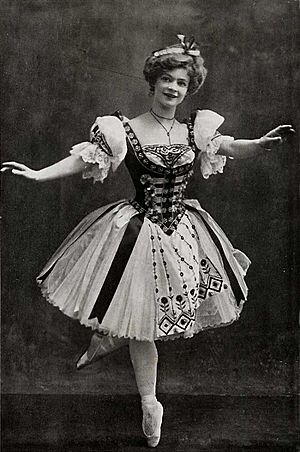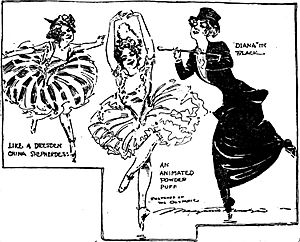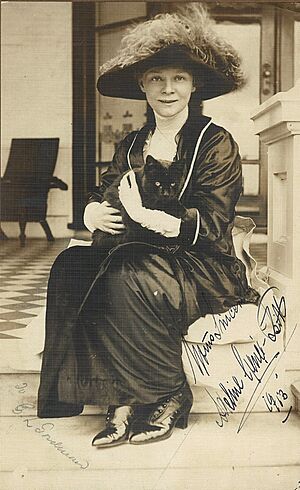Adeline Genée facts for kids
Adeline Genée was a famous Danish-British ballet dancer. She was born Anina Kirstina Margarete Petra Jensen on January 6, 1878, and passed away on April 23, 1970. She became known as Dame Adeline Genée later in her life.
Contents
Early Life of Adeline Genée
Anina Kirstina Margarete Petra Jensen was born in Hinnerup, Denmark. Her uncle, Alexandre Genée, started teaching her to dance when she was only three years old. When she was eight, her uncle and his wife adopted her. She changed her last name to Genée. She also changed her first name to Adeline, honoring a famous Italian opera singer.
Adeline had her first performance at age ten. This was with her uncle's dance company in Oslo, Norway. In 1895, she became the main dancer for the Royal Danish Ballet in Copenhagen. The next year, she danced with the Berlin Royal Opera Ballet and the Munich Opera Ballet.
Dancing at the Empire Theatre

In 1897, Adeline Genée went to London. She was hired for six weeks to dance in a show called Monte Cristo. People loved her classical dance style so much. Because of this, she was offered a special job. She became the prima ballerina (the main female dancer) at the Empire Theatre of Varieties. She stayed there for ten years.
Most of the ballets at the Empire were created by Katti Lanner. But Genée also helped create many of her own dances. She worked with her uncle Alexandre on these. Some of her successful shows there included The Press (1898) and Les Papillons (1900). She also starred in Cinderella (1906). She performed the first British show of Coppélia in 1906.
During this time, English ballet was not very popular. It often involved short dances in variety shows. Genée helped make ballet more important. She brought back older ballets and created new, more complex ones. This helped more people enjoy ballet. She was very talented. She could dance in light musical shows and also in serious classical ballets. People often said she looked like "Dresden china" because she was so graceful.
From 1905, Genée danced in 400 shows of the musical play The Little Michus. This was at Daly's Theatre.
Touring the World
In 1907, Genée traveled to the United States. She performed in The Soul Kiss in New York. The show's producer, Florenz Ziegfeld, called her "The World's Greatest Dancer" on posters. Many people in the US at that time did not know much about ballet. So, ballet shows were often part of bigger musical performances.
For several years, Genée danced in London and then in America. After she married Frank S. N. Isitt in 1910, she started performing less often. The famous ballet producer Sergei Diaghilev saw her dance. He offered her a contract, but she turned it down.
She toured America again in 1908 with The Soul Kiss. On later American tours, she danced in The Silver Star (1909) and Roses and Butterflies (1911). In Roses and Butterflies, she danced with Alexis Kosloff. He gave her a silver award, calling her "To the World's Greatest Dancer."
On December 3, 1912, she performed at the Metropolitan Opera in New York. Her show included La Camargo. In this ballet, she danced like the famous ballerina Marie Camargo. On December 17, 1912, she premiered La danse at the Met. This ballet showed the history of dancing from 1710 to 1845. It featured past ballerinas like Françoise Prévost and Marie Taglioni.
Both La Camargo and La danse were new ballets created by Genée. She worked with composer Dora Bright and designer C. Wilhelm. She took these ballets on tours to America, Australia, and New Zealand. She also performed The Dryad, another ballet she created with Bright.
On June 21, 1913, she danced her most famous role, Swanilda, in Coppélia in Melbourne, Australia. On August 6, 1913, Genée also danced in Sydney.
In 1916, she went on a sixteen-week tour of Australia. She danced a hornpipe (a lively dance) for the Australian navy. This was part of a special "Navy Night" show. When she returned to London, she gave her last big performance in April 1916. This was at the Coliseum in The Pretty Prentice. After this, she only danced for charity events. In 1923, the King of Denmark gave Genée the Ingenio et Arti medal.
Her very last performance was on March 15, 1933. It was for the early television service of the BBC. She danced with Anton Dolin in a ballet called The Love Song. This ballet was created just for her. It was broadcast to London.
Genée was given the title Dame Commander of the Order of the British Empire in 1950. A theater in East Grinstead was named the Adeline Genee Theatre after her. The Genée studio at the Royal Academy of Dance in London is also named in her honor.
Royal Academy of Dance
In 1920, Adeline Genée worked with Philip Richardson. He ran the Dancing Time magazine. Their goal was to make dance and dance teaching better in the United Kingdom. Richardson organized a meeting of important dance experts. Genée was one of the special guests. She represented the Bournonville Method of ballet from Denmark.
Other important dancers at the meeting included:
- Phyllis Bedells – representing the English Method
- Lucia Cormani – representing the Italian Method
- Edouard Espinosa – representing the French Method
- Tamara Karsavina – representing the Imperial Method from Russia
This meeting led to the creation of the Association of Teachers of Operatic Dancing of Great Britain. It officially started in December 1920. The association grew bigger and more important. Queen Mary became its Patron. In 1935, King George V gave the association a special royal charter. It then became the Royal Academy of Dancing. In 1953, Genée started the Queen Elizabeth II Coronation Award. She was the president of the academy until she retired in 1954. Dame Margot Fonteyn took over from her.
Today, the association is known as the Royal Academy of Dance (RAD). Darcey Bussell is its current president. It has become one of the biggest and most important dance teaching groups in the world. The RAD has over 14,000 members. It works in 79 countries around the globe. Each year, more than 250,000 students worldwide learn its dance syllabus.
Genée International Ballet Competition
In 1931, the association started the Adeline Genée Gold Medal Awards. These were scholarships for young dancers who wanted to be professionals. At first, only female dancers could win medals. But awards for male dancers were added in 1939. Today, the Royal Academy of Dance still offers these awards. They are now called the Genée International Ballet Competition. It is known as one of the most important dance competitions in the world.
The Genée competition brings in dancers from all over the world. Recent finals have been held in places like Australia, Canada, and Singapore. In May 2019, the competition was renamed the Margot Fonteyn Ballet Competition. This was to honor Dame Margot Fonteyn, who was the RAD's president for a very long time.
See Also
- List of dancers



